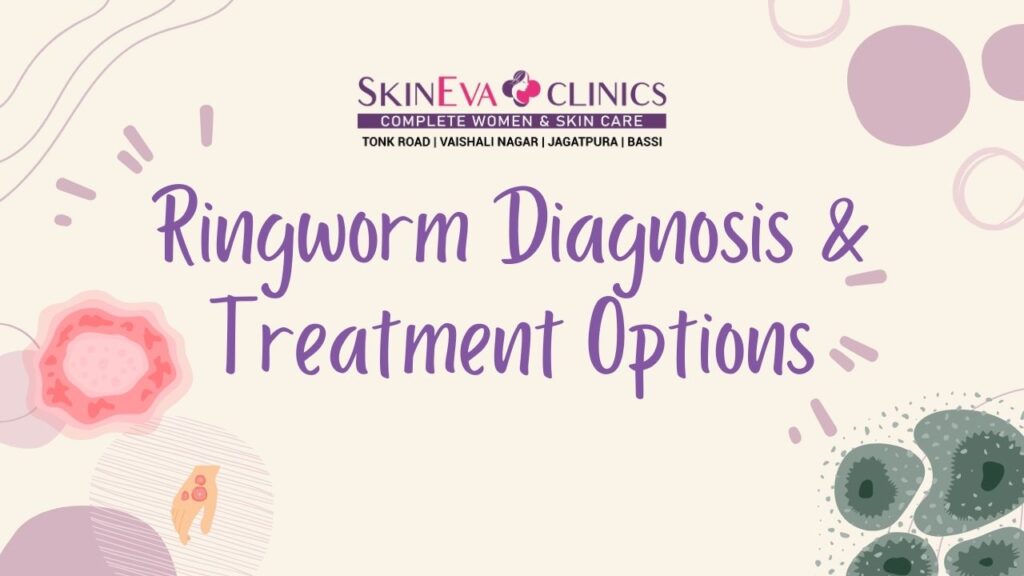Ringworm Diagnosis & Treatment Options

Ringworm is more than just a minor skin issue—it is a contagious fungal infection that can spread quickly if not managed properly. While its red, circular rash makes it easy to recognize in many cases, diagnosing ringworm accurately is important to avoid confusion with other skin conditions. The good news is that with the right medical guidance, treatment options are highly effective and can restore healthy skin, nails, and scalp. Understanding how ringworm is diagnosed and what treatments are available is the first step toward quick recovery and prevention of recurrence.
Diagnosis of Ringworm
Identifying ringworm might seem simple because of its trademark ring-shaped rash, but doctors take a systematic approach to make sure it is correctly diagnosed. Why? Skin problems like eczema or psoriasis can resemble fungal infections, making professional diagnosis important before treatment starts.
1. Clinical Examination (First Step)
Diagnosis usually begins with a physical exam. A dermatologist or healthcare provider carefully looks at the affected area for signs like:
- Red, scaly, ring-shaped patches with clearer centers
- Itchy, expanding circles that may overlap
- If the scalp is affected, symptoms can include hair loss or broken hair strands.
- Thick, brittle, or discolored nails in nail infections
Doctors may also check other parts of the body, since ringworm often spreads from one area to another (for example, athlete’s foot spreading to the hands or nails).
2. Wood’s Lamp Test (Special Light Exam)
In some cases, the doctor might use a Wood’s lamp, which is a type of ultraviolet light. Certain fungi glow under this light, usually with a bluish-green tint, making the infection easier to spot. However, not all types of fungi show up this way, so this test is often used as a supportive tool.
3. Skin Scrapings and Microscopy
To confirm the diagnosis, doctors often perform a skin scraping test:
- A small sample of the infected skin may be gently scraped for testing.
- In scalp or beard cases, doctors might take a few hairs for examination.
- For nail infections, nail clippings or debris from under the nail are collected.
These samples are then placed under a microscope. By treating the sample with a special solution (often potassium hydroxide, or KOH), doctors can see if fungal structures (called hyphae) are present.
4. Fungal Culture
Fungal culture testing helps identify the exact fungus responsible for the infection. In this case, the collected sample is placed in a special medium where fungi can grow. This is called a fungal culture. It takes a few weeks but provides the most precise result, helping guide the right treatment plan.
5. Skin Biopsy or Advanced Tests (Rare Cases)
If the infection looks unusual or doesn’t respond to treatment, doctors may perform a skin biopsy (removing a tiny piece of skin for testing) or advanced methods like PCR testing, which detects fungal DNA. These are not common but can be very useful in complicated cases.
Treatment Options for Ringworm
Treating ringworm isn’t just about getting rid of the visible rash—it’s about making sure the infection is completely cleared and preventing it from coming back. The treatment your doctor recommends depends on where the infection is located, how severe it is, and whether it has spread. Let’s explore the main treatment methods step by step.
1. Topical Antifungal Medications (First-Line for Mild Infections)
For most simple skin infections—like ringworm on the arms, legs, or torso—topical antifungals (creams, gels, ointments, or powders) are usually the first choice.
Examples include:
- Clotrimazole (Lotrimin®)
- Miconazole (Micatin®, Desenex®)
- Terbinafine (Lamisil®)
- Ketoconazole (Nizoral®)
- Tolnaftate (Tinactin®)
How they’re used:
- Apply a thin layer of cream twice daily, covering the rash and 1–2 cm around it.
- Continue treatment for 2–4 weeks, even if the symptoms improve earlier.
- Keep the infected skin clean and dry, since moisture supports fungal growth.
These medications are safe for children and adults and usually work very well when used consistently.
2. Oral Antifungal Medications (For Stubborn or Widespread Cases)
Sometimes creams aren’t enough. This is usually the case for scalp infections, nail infections, or widespread skin involvement. Here, doctors prescribe antifungal pills or syrups.
Common oral antifungals include:
- Griseofulvin – often used for scalp infections in children.
- Terbinafine – highly effective for skin and nail infections.
- Itraconazole – useful when other medications cannot be used.
- Fluconazole – sometimes given weekly for convenience.
Duration of treatment:
- Skin infections: usually 2–4 weeks
- Scalp infections: 6–8 weeks
- Nail infections: 6–12 weeks (or longer)
Since these medications work inside the body, your doctor may monitor for side effects, especially on the liver.
3. Antifungal Shampoos (For Scalp Ringworm)
When ringworm affects the scalp (tinea capitis), topical creams cannot penetrate deeply enough into the hair follicles. That’s why oral antifungal pills are the mainstay of treatment.
However, doctors often recommend using antifungal shampoos (such as those containing ketoconazole or selenium sulfide) alongside oral medication.
👉 These shampoos don’t cure the infection by themselves but they reduce the number of spores, which helps prevent spreading to others in the household. Sometimes, family members are also advised to use these shampoos as a precaution.
4. Special Treatments for Nail Ringworm
Nail infections (tinea unguium) are the most stubborn form of ringworm. They almost always require oral antifungal medication, since creams cannot penetrate the nail plate.
- Terbinafine is the preferred oral medicine, typically for 6 weeks on fingernails and 12 weeks on toenails.
- Itraconazole pulse therapy is another option, where medication is taken for one week per month over several months.
- In some cases, doctors may recommend medicated nail lacquers (though they work better as supportive therapy rather than the main treatment).
5. Supportive Care and Hygiene
Medicine alone isn’t enough—your daily habits also play a huge role in treatment success. Here’s what helps:
- Maintain dryness in the affected area — fungi thrive in moist conditions.
- Avoid scratching – it can worsen irritation or cause secondary bacterial infections.
- Wash clothes, towels, and bedding in hot water to destroy fungal spores.
- Avoid sharing personal belongings such as shoes, hats, towels, or combs.
- Wear breathable clothing and footwear to reduce sweating and moisture buildup.
- Use shower shoes in gyms, pools, or public locker rooms.
Conclusion
Though ringworm can cause irritation and discomfort, it responds well to proper treatment and timely diagnosis. From antifungal creams to oral medications, doctors have several effective options to stop the infection and prevent it from spreading further. The key is to seek medical attention at the right time, as delays may worsen the condition. With professional care and preventive measures, ringworm can be treated successfully while also lowering the chances of recurrence.



Leave a Comment